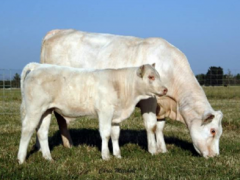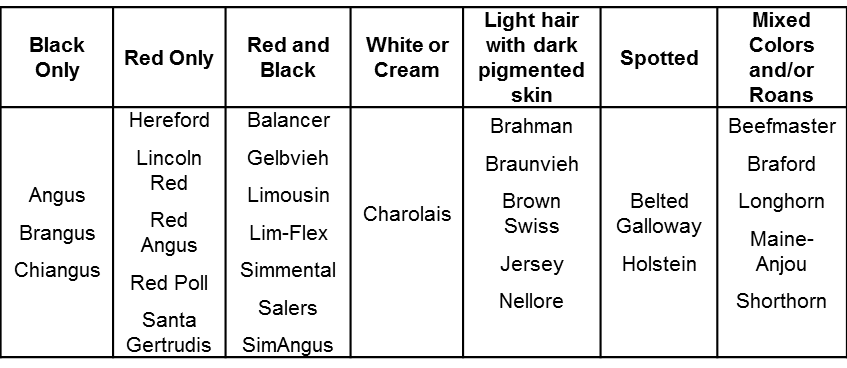How Do You Get A Smoke Colored Calf

Color Patterns in
Crossbred Beef Cattle
Megan Rolf
Oklahoma Land Academy
mrolf@okstate.edu
*Click here for printable pdf version.
Summary: Agreement the genetic basis of coat color can assistance create more than uniform progeny groups and aid in marketing crossbred calves.
Crossbreeding provides commercial cattlemen the opportunity to combine desirable characteristics of two or more breeds (breed complementarity – run across fact sheet 2014-v) and increase functioning due to hybrid vigor (heterosis). The unmarried strongest argument for crossbreeding is the advantage in fertility and longevity of crossbred cows. With all of the advantages crossbreeding provides, designing an effective mating system should be a meridian priority for all commercial cattlemen. To plan an effective crossbreeding system, it is helpful to consider any potential detractors that are easy to accost. One such detractor exists due to marketplace bigotry against certain breeds and/or colors and lack of uniformity in color. Every bit nosotros increment the number and diversity of breeds involved in crosses, we subtract our ability to maintain complete command of coat color in the offspring unless it was taken into account during brood pick. With that in mind, knowing the nuts of glaze color inheritance can help producers know what to expect from various breed/composite pairings relative to color design.
The purpose of this fact sheet is to provide guidance on how to maintain a compatible color pattern when formulatingcrossbreeding systems. In some breeds and breed crosses, the colour is highly predictable; however, in some other breeds and breed crosses, color is less predictable. A working knowledge of the inheritance of coat colour will aid in planning for the color pattern to await among calves when crossing breeds. This can exist very important for evaluating marketing options either at weaning when forming large group lots or on the rail when targeting specific branded beef programs.
Many breeds of beef cattle have a stock-still color pattern for that breed considering selection has been placed on the color in order to maintain these characteristics. For example, all Hereford cattle have a red trunk color with a white face, all Charolais are white, and all Scarlet Poll are carmine. Yet, other breeds may have more one basic body color such as cerise or blackness Limousin or Simmental, and white, cherry, or roan Shorthorn. Nonetheless other breeds have multiple colors with more than unpredictable inheritance patterns, such as spotting, brindling, or stripes in Longhorn and Beefmasters. Some color modifiers nether genetic control have been selected against in many breeds (unless they are a characteristic of colour in the brood, such as inCharolais or Hereford) and these features, such as "diluters" and blaze faces, are much less mutual than in the past which makes the process of managing color in crossbreeding systems much easier.
Table 1 shows several common breeds of beef cattle and the predominant color design that is most commonly associated with each breed. Recently, some breeds with unique color attributes such as spots, blaze faces, and diluter genes have selected against these traits to increase favorable perceptions by final buyers. Other breeds that were traditionally red have selected heavily for black coat color and are listed in Tabular array 1 as both black and cherry-red. Introgression of other breeds (specifically Angus) into some of the Continental breeds has altered the traditional color blueprint of some of these breeds. Colour patterns likely to event from specific crosses are detailed in Table two.
| Tabular array i. Basic torso colors of common cattle breeds. |
 |
| Tabular array 2. Color design expected in progeny resulting from the matings of bulls and cows of diverse colors. |
 |
All animals are carriers of mutations somewhere in their Dna for one or many recessive traits. Because an animal must inherit 2 copies of a given recessive mutation to be affected, and with only a few animals typically sharing the same mutation in the whole population, in that location is rarely a mating cantankerous that has the potential to create affected offspring under natural option. It is when relatives are mated that there is the possibility that offspring will inherit the mutant allele on both sides of the family unit tree.
When yous accept crossbred cows, predicting colour in the offspring can be more difficult, but information technology helps to sympathize how colour is inherited. All cattle basically possess one of iii basic colors: black, red, or white. Blackness is ascendant to reddish, and both blackness and carmine are co-dominant with white. One black or red allele with a white allele would result in either a black or red roan animal. In order for an beast to be red or white, they must have two alleles for either ruby or white, respectively. There is some other set up of alleles that controls the dilution, or intensity, of that colour. Dilution causesblack to be muted to gray and reddish to be muted to yellowish. As an example, Charolais cattle are ruby-red, only possess ii alleles for dilution, which results in white coat colour (Gutiérrez-Gil et al. 2007). This is why Charolais ten Angus cattle are grey (diluted black). A very thorough word of glaze color in cattle, including its many variations (Table three) tin be institute at http://simmental.org/site/pdf/other/olsoncolor.pdf.
| Tabular array 3. Description of known coat color patterns in cattle (adapted from Olson 1999). |
 |
In a typical auction barn market place, cattle are sold with little, if whatever, data fabricated available near breed or performance. Many buyers will estimate performance (growth, carcass characteristics, etc.) in relation to the reputation of the breed; thus, they may look for signs that indicate a certain breed or breeds within crossbred cattle. Other buyers may be looking to source animals that qualify for black- or scarlet-hided branded beefiness programs and are willing to pay a premium for these types of calves. Some breeds are prone to producing calves that have certain distinguished colour markings, such as white-faces, brindling, or white stockings on their legs.
Some general rules can be utilized to requite the greatest take chances of obtaining uniformly-colored groups of calves. Because cherry-red is recessive to black coat color, breeding solid red cows and bulls volition produce solid ruddy calves, which makes solid crimson an easy color to maintain in a crossbreeding organization. Still, considering black is ascendant to red, breeding solid black bulls and cows will often produce black calves, just may too yield cherry calves. To ensure a solid black dogie ingather, breed solid colored females (without diluter genes) to a homozygous blackness balderdash. If black baldy calves are desirable, use of Hereford bulls on black cows (or blackness bulls on Hereford cows) will yield the desired issue. If color extremes in the cowherd are a major concern, they can be masked by convenance over several generations to Charolais bulls.
In today's market, where marketing branded beef is advantageous, cognition of glaze color inheritance is essential. Even under traditional marketing systems, uniformity in coat color tin can ofttimes provide premiums/discounts in the market place. Therefore, knowing the basics of colour inheritance volition help in planning crossbreeding systems that create animals that are suitable for desired marketing niches or branded programs.
*Click hither for printable pdf version.
Source: https://beef-cattle.extension.org/color-patterns-in-crossbred-beef-cattle/
Posted by: jamesmethery.blogspot.com

0 Response to "How Do You Get A Smoke Colored Calf"
Post a Comment